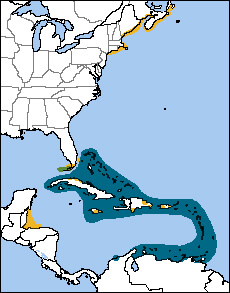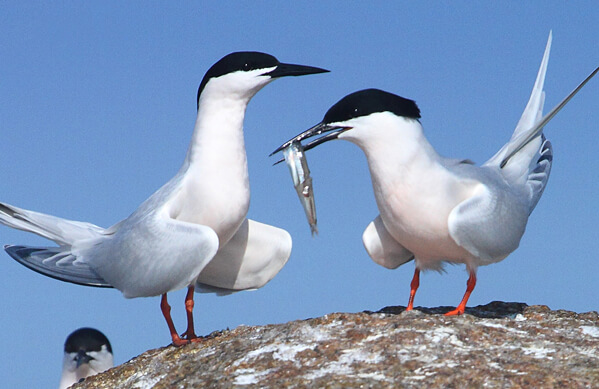 The Roseate Tern is a medium-sized tern with a deeply forked tail that sports long white plumes when the bird is in breeding plumage. The species' common name reflects the delicate pinkish wash visible on the birds' chests when plumage is fresh.
The Roseate Tern is a medium-sized tern with a deeply forked tail that sports long white plumes when the bird is in breeding plumage. The species' common name reflects the delicate pinkish wash visible on the birds' chests when plumage is fresh.
By the late 19th century, U.S. populations of Roseate Tern had declined steeply due to plume hunting. Although populations have stabilized since, the northeast population is listed as endangered under the Endangered Species Act (ESA), and habitat loss, climate change, collisions, and predation continue to be threats.
Found on Six Continents
Like the Gull-billed Tern, the Roseate Tern has a worldwide distribution, from Europe to Africa to Australia. Roseate Terns are divided into four subspecies based on small differences in size and bill color.
The North American subspecies (Sterna dougallii dougallii) is further divided into two separate breeding populations; one in the northeastern U.S. and Nova Scotia and another in the southeastern U.S. and Caribbean. Both populations winter in the Caribbean and along the northeastern coasts of South America.
Sign up for ABC's eNews to learn how you can help protect birds
Petite Pirate
The Roseate Tern is a bird of marine coastal areas and forages for small fish over both shallow coastal inlets and far offshore. While breeding, U.S. birds primarily feed on American sand lance—so much so that their nesting success rates may be related to the abundance and proximity of this small fish.
Like Least and Inca Terns, the Roseate Tern captures food mainly by plunge-diving, completely submerging underwater to catch prey. Unusual for a tern, the Roseate Tern shows some kleptoparasitic (food-stealing) behavior, snatching fish from other bird species such as Common Tern or Atlantic Puffin.
Cover from the Commons
Roseate Terns nest along the coast or on small barrier islands. They construct a simple scrape as a nest, usually hiding it from predators under some sort of protective cover such as a rock overhang, vegetation, or washed-up debris.
Roseate Terns in the U.S. almost always nest in colonies with Common Terns. Since Roseates are less defensive of their nests and young than other terns, they often rely on the Common Terns in the surrounding colony to defend them. Roseate Terns are so skittish that they will readily abandon eggs and chicks if approached too closely and too often.

Roseate Terns, adults and juveniles by Earnest Tse, Shutterstock
In 1987, the northeast U.S. population of the tern was listed as endangered under the ESA; the remainder of the Roseate Tern population in the Western Hemisphere is listed as threatened. It is also classified as a species of urgent conservation concern by NABCI (the North American Bird Conservation Initiative) and is included on the 2016 State of the Birds Watch List.
As a result, most breeding colonies of Roseate Terns in the northeast are intensively managed; predator control and provision of artificial nesting areas have led to increased breeding success at many sites.
Roseate Tern and Offshore Wind
At ABC, we are concerned about the prospect of a new source of mortality, given that the U.S. Department of the Interior's Bureau of Ocean Energy Management has leased several areas on the eastern continental shelf and designated them for large-scale offshore wind energy development.
If this development moves forward, it will affect the coasts of South Carolina, North Carolina, Virginia, Maryland, Delaware, New Jersey, New York, Connecticut, Massachusetts, and Maine—including much of the migratory pathway of the Roseate Tern.
With several partner groups, we have asked federal agencies to consider these impacts and ensure that proper environmental assessments be conducted.
Donate to support ABC's conservation mission!



















































